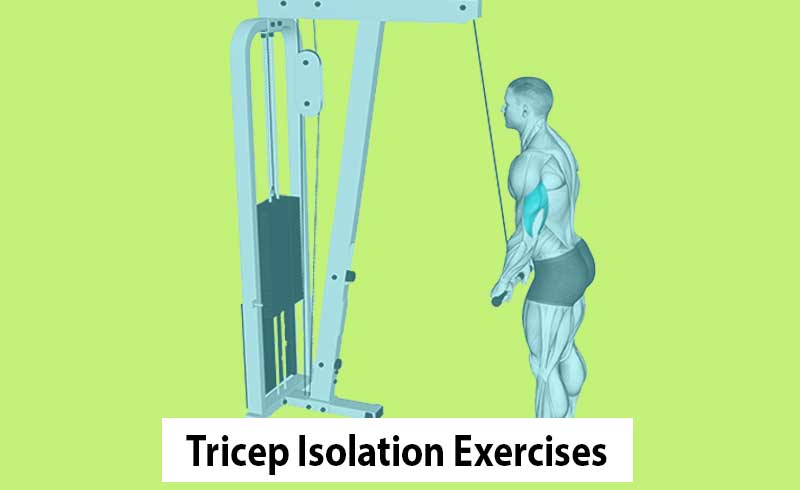Want bigger, stronger triceps and better-looking arms? Well, it’s time to talk about tricep isolation exercises. These exercises are like specialists for your triceps.
If you really want to make your triceps strong and work on all three parts, you should focus on isolation exercises. They’re like secret weapons for amazing triceps.
In this guide, we’ll cover these important things:
- Triceps Anatomy: Learn about the different parts of your triceps.
- Top Isolation Exercises For Triceps with dumbbells, cables, machine, resistance band, and barbell.
- Tips for Better Workouts: Get expert advice to make your tricep workouts more effective.
- Workout Plans: Make your own workouts that match your goals.
- Adding Isolation Exercises: Learn how to fit them into your routine.
- FAQs
Get ready to see the power of isolation tricep exercises and build stronger, better-looking arms!
The Tricep Anatomy
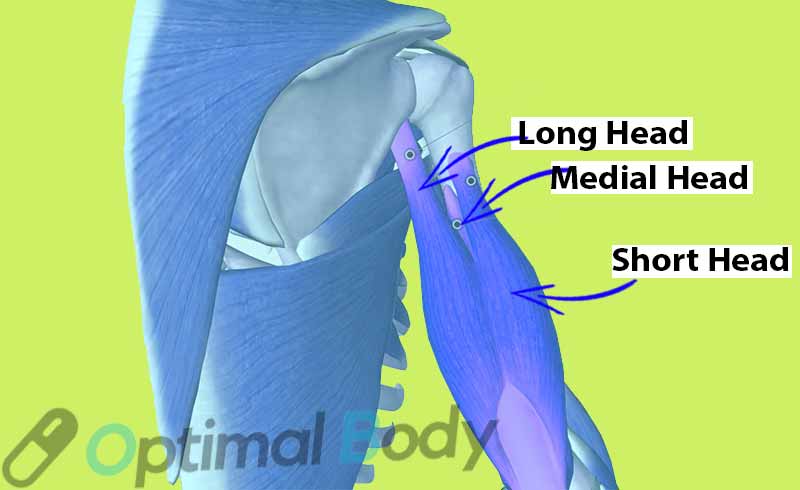
The triceps brachii, commonly known as the triceps, is a three-headed muscle located on the back of the upper arm.
It consists of the long head, lateral head, and medial head, with all three heads converging into a single tendon that attaches to the ulna’s olecranon process.
The primary function of the triceps is to extend (straighten) the elbow joint, opposing the flexion initiated by muscles like the biceps.
Additionally, it contributes to shoulder extension and plays a crucial role in stabilizing and supporting pushing or pressing movements.
Strong tricep muscles are essential for arm extension, and overall arm stability during various daily activities and workouts.
The Best Tricep Isolation Exercises
Here are 10 of the best tricep isolation exercises to build strength and muscle mass.
1. Straight Bar Tricep Pushdown
Straight bar pushdowns are a simple and effective exercise for strengthening and toning the muscles in the back of your upper arms, which are called the triceps. It’s often done using a cable machine at the gym.
How to Perform Straight Bar Pushdowns:
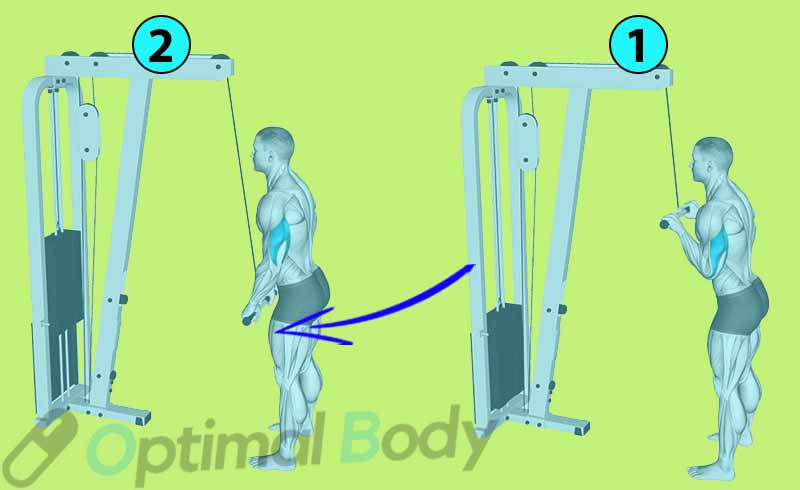
- Stand in front of the cable machine and attach a straight bar to the high pulley.
- Grasp the bar with both hands, palms facing downward, maintaining a shoulder-width grip.
- Stand upright with your chest held high and a slight forward lean.
- Activate your triceps by extending your elbows and pushing the bar downward towards your thighs. Keep your upper arms close to your body.
- Maintain a straight line between your wrists and forearms throughout the movement.
- Upon reaching a full extension with straightened elbows, briefly contract and squeeze your triceps.
- Slowly and with control, release the bar, allowing it to return until your elbows reach a 90-degree bend.
- Repeat this sequence for your desired number of repetitions.
Benefits:
- Effective Tricep Workout: Targets the long head of the triceps for strength and muscle growth.
- Easy Execution: Suitable for beginners and experienced lifters due to its simplicity.
- Progressive Overloading: Allows for increasing weight to challenge triceps for muscle and strength gains.
Exercise Tips:
- Maintain Form: Keep chest up, elbows close, and wrists straight for effective triceps engagement.
- Avoid Cheating: Focus on using triceps, avoiding momentum or other muscles.
- Add Variety: Incorporate different tricep exercises like rope pushdowns, single-arm press-outs, or close-grip dips to prevent monotony and work muscles differently.
2. Dumbbell Tricep Kickbacks
The Dumbbell Kickback, also known as the Tricep Kickback, is a valuable exercise in strength training and bodybuilding, primarily targeting the triceps, the muscles on the back of your upper arms.
To fully benefit from this exercise, correct execution is essential.
How to do Tricep Kickbacks:
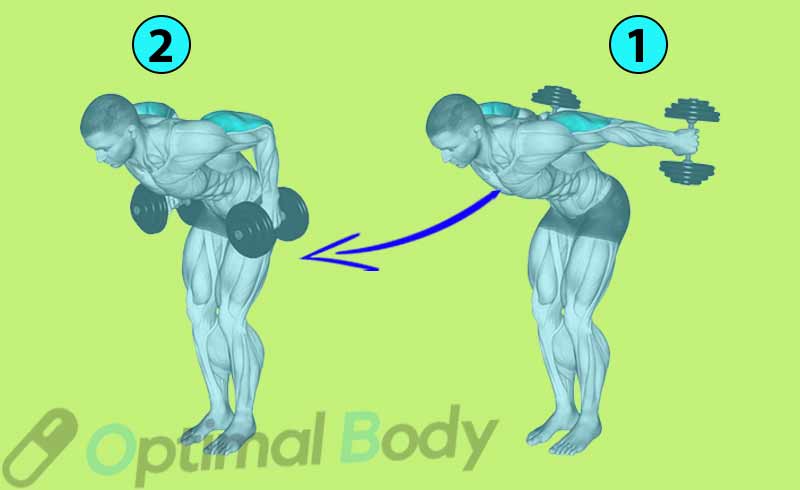
- Stand with your feet hip-width apart, holding a dumbbell in each hand.
- Bend your knees slightly and hinge forward at the hips.
- Keep your upper arms close to your torso as you extend your arms straight behind you.
- Squeeze your triceps at the top of the movement, then return to the starting position.
Benefits:
- Isolation: Tricep kickbacks isolate and target the triceps, helping to tone and strengthen them.
- Ease of Access: These can be done with minimal equipment, making them a convenient choice.
- Variation: You can use different weights to tailor the intensity of the exercise to your fitness level.
Tips:
- Focus on the mind-muscle connection to engage your triceps throughout the movement.
- Keep your back straight and your core engaged for stability.
3. Tricep Rope Pushdowns
The Rope Triceps Pushdown is a common exercise in weightlifting and bodybuilding, primarily targeting the triceps muscle group.
It is performed using a cable machine and a rope attachment. This exercise provides a neutral grip, meaning your palms are facing each other when holding the rope, and it offers a more forgiving hand positioning compared to other variations of triceps pushdowns.
How to do Rope Tricep Pushdown:
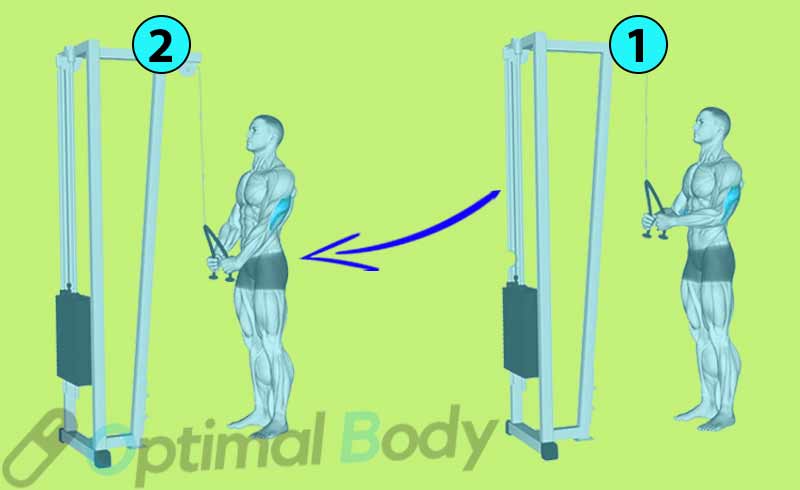
- Attach a rope handle to the high pulley of a cable machine.
- Stand facing the machine with your feet shoulder-width apart.
- Hold the rope with both hands, palms facing down, and elbows close to your sides.
- Push the rope down by extending your elbows until your arms are fully extended.
- Return to the starting position with controlled motion.
Benefits:
- Precise Isolation: Tricep rope pushdowns allow you to precisely isolate and target the triceps.
- Customizable Resistance: You can adjust the weight on the cable machine for the desired resistance level.
- It allows for a full range of motion, ensuring that you engage the triceps throughout the movement.
- Constant Tension: The cable keeps constant tension on your triceps, maximizing the workout’s effectiveness.
Tips:
- Maintain a stable stance with a slight bend in your knees.
- Focus on controlling the weight throughout the entire range of motion.
4. Lying Tricep Extensions
The lying triceps extension, also known as the skull crusher or French press, is a popular exercise that targets the triceps, located on the back of the upper arms. It’s crucial for building well-defined triceps but requires proper form.
You can do other variations of it like the cable lying extension.
How to do Lying Tricep Extension:
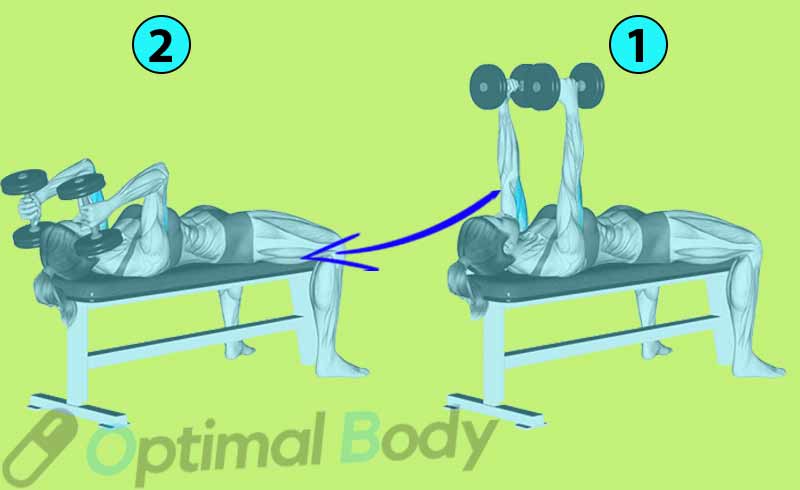
- Lie flat on a bench with a barbell or dumbbells in your hands, arms extended upward.
- Bend your elbows to lower the weight toward your forehead, keeping your upper arms stationary.
- Extend your arms to push the weight back up to the starting position.
Benefits:
- Focused Tricep Work: Skull crushers concentrate on the triceps, helping to build strength and definition.
- Long Head Emphasis: This exercise targets the long head of the triceps.
- Compound Engagement: While primarily a tricep exercise, skull crushers also involve the chest and shoulders to a lesser extent.
Tips:
- Use a spotter or choose an appropriate weight to ensure safety.
- Perform the exercise with controlled, deliberate movements to prevent injury.
5. Tricep Overhead Extensions
Tricep overhead extensions are a single-joint resistance exercise designed to promote triceps brachii muscle hypertrophy.
They serve as an accessory movement in push or chest-and-triceps workouts to provide low-resistance training volume, with a focus on the triceps.
It can be done using a resistance band.
How to do Dumbbell Tricep Overhead Extensions:
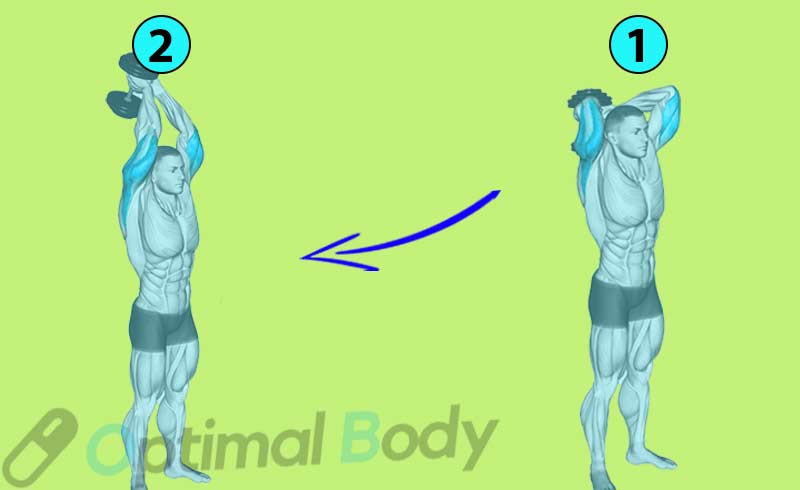
- Hold a dumbbell with both hands, palms facing up.
- Extend your arms upward, keeping your elbows close to your head.
- Bend your elbows to lower the weight behind your head.
- Push the weight back up to the starting position.
Benefits:
- Tricep Isolation: Tricep overhead extensions isolate and strengthen the triceps effectively.
- Long Head Emphasis: This exercise focuses on the long head of the triceps, aiding in balanced development.
- Versatility: Tricep overhead extensions can be performed in either a seated or standing position.
Tips:
- Engage your core for stability and support during the exercise.
- Maintain proper form to avoid straining your shoulders.
6. Single-Arm Tricep Extension
The one-arm overhead dumbbell extension enhances triceps symmetry and strength by requiring unilateral lifting.
Although unilateral training can extend workout duration, this exercise is essential for correcting upper arm muscle imbalances, ensuring both triceps get equal attention
How to do One-Arm Dumbbell Tricep Extensions:
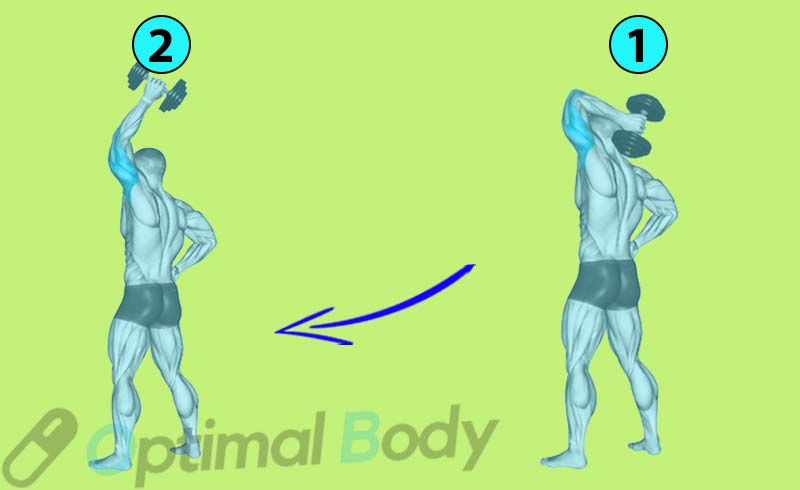
- Stand with your feet shoulder-width apart and hold a dumbbell in one hand.
- Raise the dumbbell overhead, keeping your arm straight and your palm facing inward.
- Bend your elbow to lower the weight behind your head, making sure your upper arm stays close to your head.
- Extend your arm back to the starting position, fully straightening it.
- Repeat.
Benefits:
- Individual Tricep Focus: This exercise allows you to target each tricep individually, addressing any strength imbalances.
- Improved Muscle Connection: Working one arm at a time can help you establish a stronger mind-muscle connection.
- Functional Strength: It can improve functional strength for activities that require unilateral (one-sided) arm movement.
Tips:
- Focus on maintaining a stable core to prevent swaying or leaning to one side.
- Use controlled movements to ensure proper form and safety.
7. Reverse Grip Tricep Pushdowns
A reverse grip tricep pushdown is a variation with palms up. It’s also known as a reverse grip pressdown, reverse grip tricep extension, or reverse grip cable pushdown, all describing the same exercise.
The reverse grip alters hand and body positioning, subtly impacting exercise mechanics.
How to do Reverse Grip Tricep Pushdown:
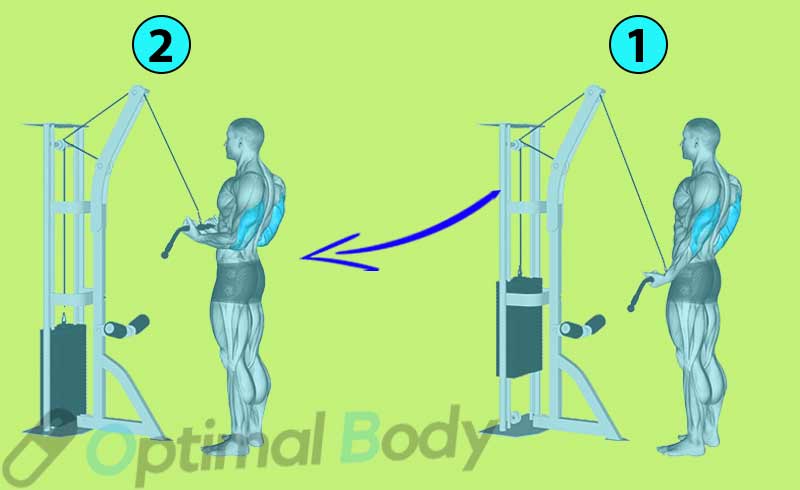
- Attach a straight bar attachment to the high pulley of a cable machine.
- Stand facing the machine with your feet shoulder-width apart.
- Grasp the bar with an underhand grip (palms facing upward).
- Keep your elbows close to your sides and push the bar down, extending your arms.
- Slowly return to the starting position, maintaining control throughout the movement.
Benefits:
- Unique Angle: The reverse grip targets the triceps in a distinct way, helping to stimulate muscle growth.
- Variation: Provides variety to your tricep workout routine, preventing plateaus.
- Improved Muscle Balance: Works different parts of the triceps to promote balanced development.
Tips:
- Use a weight that allows you to maintain proper form and control.
- Keep your core engaged for stability.
8. Close Grip Tricep Pushdown (V Bar)
v bar pushdowns are a cable machine exercise that mimics the motion of diamond push-ups, offering a targeted tricep workout.
How to do:
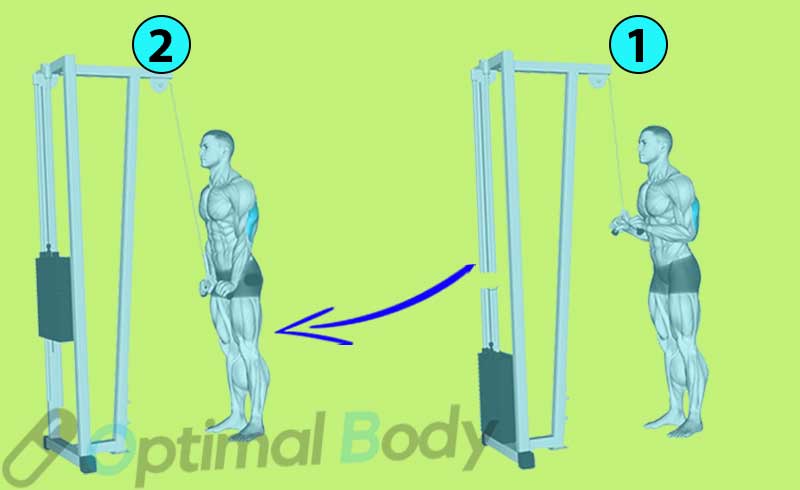
- Attach a V bar handle to the high pulley of a cable machine.
- Stand facing the machine with your feet shoulder-width apart.
- Hold the V bar with your hands close together, forming a diamond shape.
- Keep your elbows close to your sides and push the rope down, extending your arms.
- Return to the starting position while maintaining control.
Benefits:
- Focused Tricep Isolation: Diamond tricep pushdowns effectively isolate and strengthen the triceps.
- Replicates Diamond Push-Ups: This exercise mirrors the muscle engagement of diamond push-ups but with added resistance.
- Sculpts the Triceps: Helps define and sculpt the triceps for a more chiseled appearance.
Tips:
- Focus on squeezing your triceps at the bottom of the movement.
- Use a weight that challenges you but allows for proper form.
9. Cable Tricep Kickback
Cable kickbacks are a tricep exercise that targets one arm at a time, helping to isolate and strengthen the triceps.
It’s often used as a finishing exercise and keeps constant tension on the triceps throughout the movement.
How to Perform:
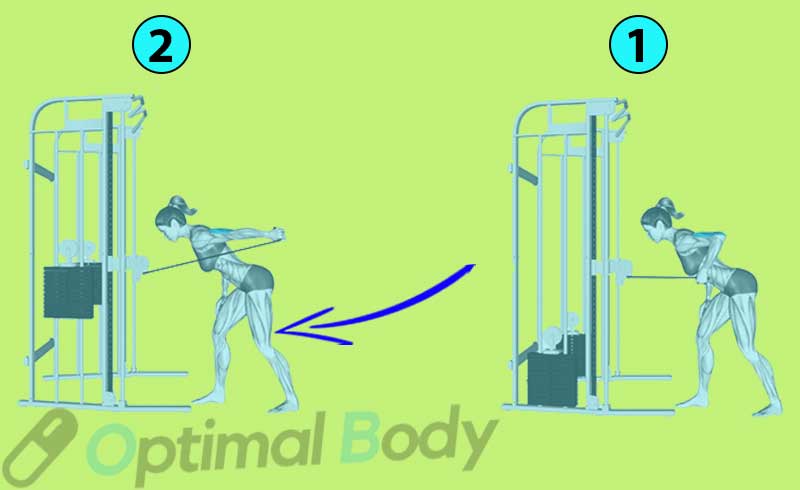
- Stand facing a cable machine with a handle attached to the low pulley.
- Grab the handle with one hand, keeping no additional weights on the machine.
- Lean forward, nearly parallel to the ground, bending at the hips.
- Begin with your elbow at a 90-degree angle, close to your chest.
- Extend your elbow, pushing your hand back while keeping the upper arm stationary.
- Return to the starting position by bending your elbow.
- Do the same with the other hand.
Benefits:
- Sustained Tension: Cable kickbacks maintain tricep tension, aiding muscle engagement, growth, and faster fatigue.
- Low Impact: Gentle on the body, suitable for use even when fatigued.
Exercise Tips:
- Light Loading: Cable kickbacks typically involve lighter weights, not ideal for heavy tricep lifting.
- Higher Reps: Due to lighter weight, aim for 20-30 repetitions for effectiveness.
FAQs:
What exercise isolates the triceps?
An exercise like the tricep pushdown or tricep kickback isolates the triceps because it mainly targets the back of your upper arms, helping them get stronger and more defined.
How do you hit all 3 muscles in your tricep?
To work all three tricep muscles (long, lateral, and medial heads), include exercises like tricep dips, close-grip bench press, and overhead tricep extensions in your routine. These movements target different parts of the triceps.
Do triceps need isolation?
Triceps can benefit from isolation exercises, as they help in sculpting and strengthening the muscles. However, compound exercises like push-ups and bench presses also work the triceps, so a mix of both can be effective.
How many tricep isolation exercises should I do?
Doing 2-3 tricep isolation exercises in your workout routine is usually sufficient. Focus on quality reps and progressively increasing weight to see gains in tricep strength and size.
Conclusion:
By incorporating these tricep isolation exercises into your fitness routine, you can further diversify your tricep training and achieve well-rounded development.
As always, start with appropriate resistance levels and prioritize proper form to get the most out of these exercises while minimizing the risk of injury.
References:
- Bench Press Calculator - April 22, 2024
- Press to Handstand: Ultimate Step-by-Step Guide - April 22, 2024
- Cable Press (How To Do, Benefits, Targeted Muscles, Alternative) - April 22, 2024

